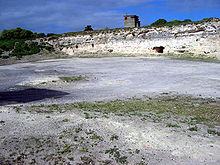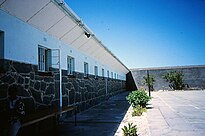Robben Island: 1964–1982
Mandela and his co-accused were transferred from Pretoria to the prison on Robben Island, remaining there for the next 18 years.[129] Isolated from non-political prisoners in Section B, Mandela was imprisoned in a damp concrete cell measuring 8 feet (2.4 m) by 7 feet (2.1 m), with a straw mat on which to sleep.[130] Verbally and physically harassed by several white prison wardens, the Rivonia Trial prisoners spent their days breaking rocks into gravel, until being reassigned in January 1965 to work in a lime quarry. Mandela was initially forbidden to wear sunglasses, and the glare from the lime permanently damaged his eyesight.[131] At night, he worked on his LLB degree, but newspapers were forbidden, and he was locked in solitary confinement on several occasions for possessing smuggled news clippings.[132] Initially classified as the lowest grade of prisoner, Class D, he was permitted one visit and one letter every six months, although all mail was heavily censored.[133]
The political prisoners took part in work and hunger strikes – the latter considered largely ineffective by Mandela – to improve prison conditions, viewing this as a microcosm of the anti-apartheid struggle.[134] ANC prisoners elected him to their four-man "High Organ" along with Sisulu, Govan Mbeki and Raymond Mhlaba, and he involved himself in a group representing all political prisoners on the island, Ulundi, through which he forged links with PAC and Yu Chi Chan Club members.[135] Initiating the "University of Robben Island", whereby prisoners lectured on their own areas of expertise, he debated topics such as homosexuality and politics with his comrades, getting into fierce arguments on the latter with Marxists like Mbeki and Harry Gwala.[136] Though attending Christian Sunday services, Mandela studied Islam.[137] He also studied Afrikaans, hoping to build a mutual respect with the warders and convert them to his cause.[138] Various official visitors met with Mandela; most significant was the liberal parliamentary representativeHelen Suzman of the Progressive Party, who championed Mandela's cause outside prison.[139] In September 1970 he met British Labour Party MP Dennis Healey.[140] South African Minister of Justice Jimmy Krugervisited in December 1974, but he and Mandela did not get on.[141] His mother visited in 1968, dying shortly after, and his firstborn son Thembi died in a car accident the following year; Mandela was forbidden from attending either funeral.[142] His wife was rarely able to visit, being regularly imprisoned for political activity, and his daughters first visited in December 1975; Winnie got out of prison in 1977 but was forcibly settled inBrandfort, still unable to visit him.[143]
From 1967, prison conditions improved; black prisoners were given trousers rather than shorts, games were permitted, and the standard of their food was raised.[145] Mandela later commented on how football "made us feel alive and triumphant despite the situation we found ourselves in".[146] In 1969, an escape plan for Mandela was developed by Gordon Bruce, but it was abandoned after being infiltrated by an agent of theSouth African Bureau of State Security (BOSS), who hoped to see Mandela shot during the escape.[147] In 1970, Commander Piet Badenhorst became commanding officer. Mandela, seeing an increase in the physical and mental abuse of prisoners, complained to visiting judges, who had Badenhorst reassigned.[148] He was replaced by Commander Willie Willemse, who developed a co-operative relationship with Mandela and was keen to improve prison standards.[149]
By 1975, Mandela had become a Class A prisoner,[150] allowing greater numbers of visits and letters; he corresponded with anti-apartheid activists like Mangosuthu Buthelezi and Desmond Tutu.[151] That year, he began his autobiography, which was smuggled to London, but remained unpublished at the time; prison authorities discovered several pages, and his study privileges were stopped for four years.[152] Instead he devoted his spare time to gardening and reading until he resumed his LLB degree studies in 1980.[153]
By the late 1960s, Mandela's fame had been eclipsed by Steve Biko and the Black Consciousness Movement (BCM). Seeing the ANC as ineffectual, the BCM called for militant action, but following the Soweto uprising of 1976, many BCM activists were imprisoned on Robben Island.[154] Mandela tried to build a relationship with these young radicals, although he was critical of their racialism and contempt for white anti-apartheid activists.[155] Renewed international interest in his plight came in July 1978, when he celebrated his 60th birthday.[156] He was awarded an honorary doctorate in Lesotho, the Jawaharlal Nehru Award for International Understanding in India in 1979, and the Freedom of the City of Glasgow, Scotland in 1981.[157] In March 1980 the slogan "Free Mandela!" was developed by journalist Percy Qoboza, sparking an international campaign that led the UN Security Council to call for his release.[158] Despite increasing foreign pressure, the government refused, relying on powerful foreign Cold War allies in US President Ronald Reagan and UK Prime Minister Margaret Thatcher; both considered Mandela's ANC a terrorist organisation sympathetic to communism and supported its suppression.[159]



No comments:
Post a Comment